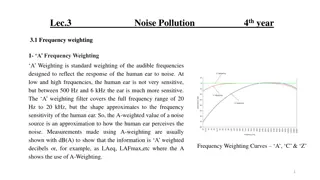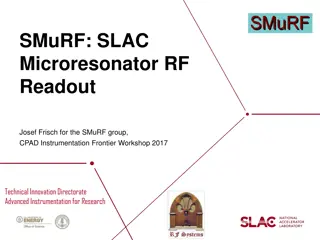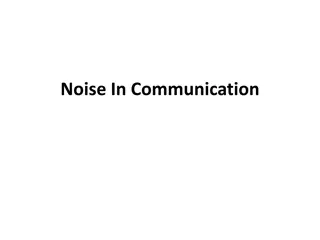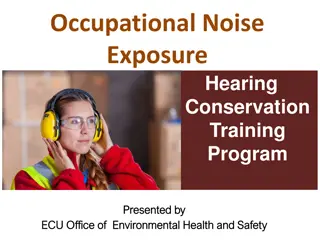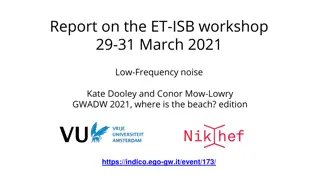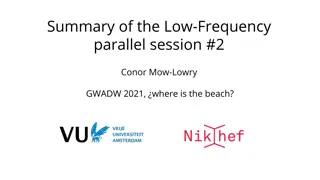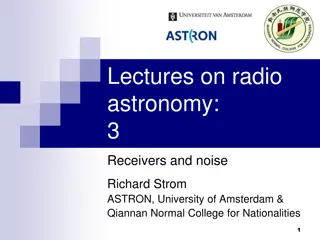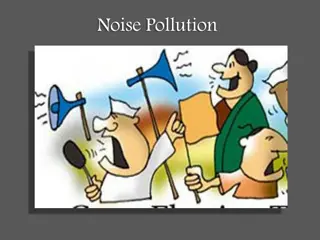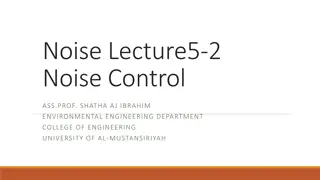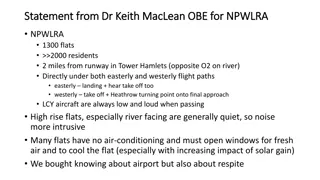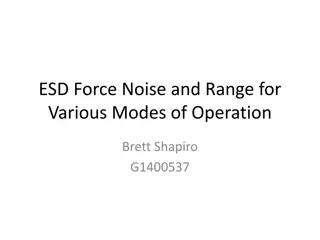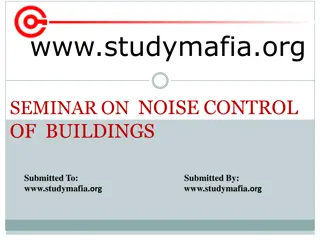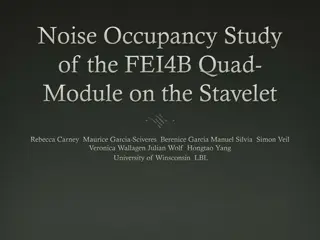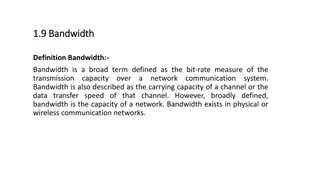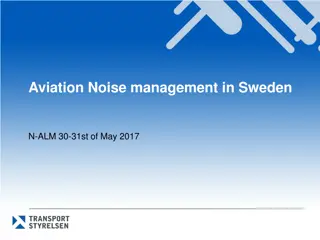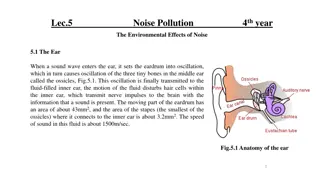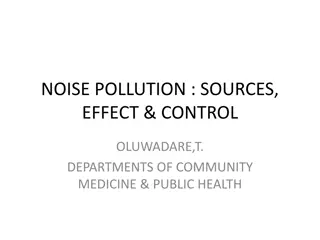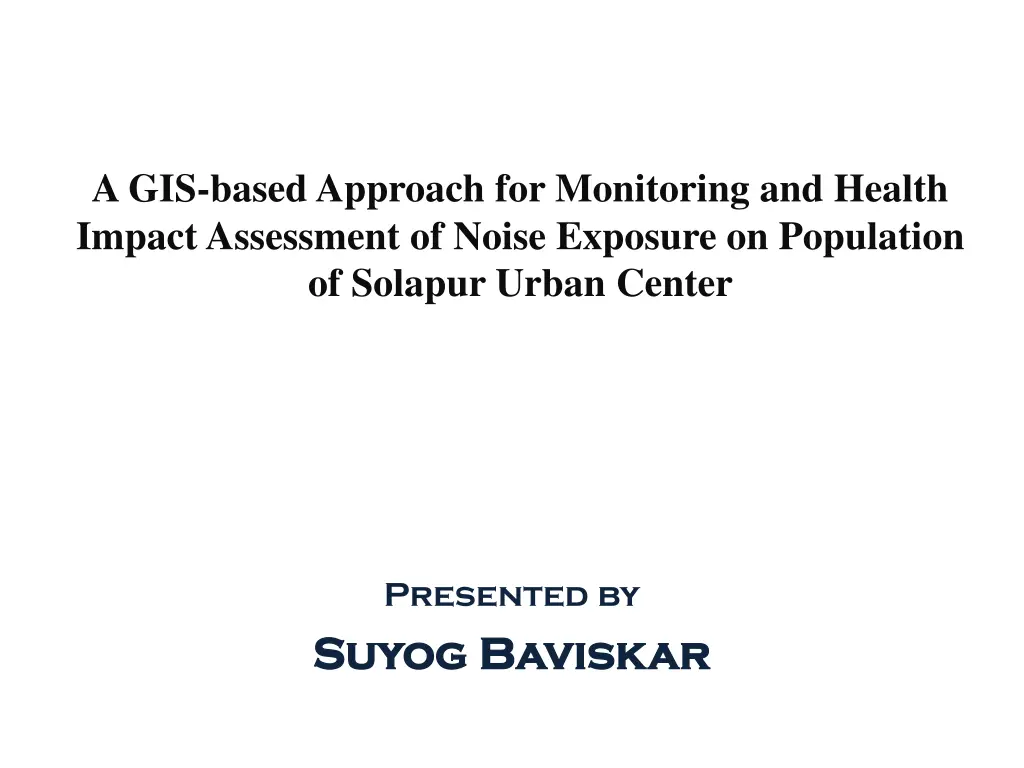
GIS-Based Noise Pollution Monitoring and Health Impact Assessment in Solapur Urban Center
This study presented by Suyog Baviskar focuses on monitoring and health impact assessment of noise exposure on the population of Solapur Urban Center using a GIS-based approach. It covers sources of noise pollution, effects of noise on health, and psychological manifestations. The research delves into the detrimental impacts of noise pollution on human health, ranging from physical effects like headaches and heart issues to psychological effects including depression and insomnia. The findings aim to raise awareness and guide mitigation strategies for noise pollution in urban areas.
Download Presentation

Please find below an Image/Link to download the presentation.
The content on the website is provided AS IS for your information and personal use only. It may not be sold, licensed, or shared on other websites without obtaining consent from the author. If you encounter any issues during the download, it is possible that the publisher has removed the file from their server.
You are allowed to download the files provided on this website for personal or commercial use, subject to the condition that they are used lawfully. All files are the property of their respective owners.
The content on the website is provided AS IS for your information and personal use only. It may not be sold, licensed, or shared on other websites without obtaining consent from the author.
E N D
Presentation Transcript
A GIS-based Approach for Monitoring and Health Impact Assessment of Noise Exposure on Population of Solapur Urban Center Presented by Suyog Baviskar Suyog Baviskar
INTRODUCTION According to Odum, noise pollution is the unwanted sound dumped into environment without regard to the adverse effect it may have. Noise pollution may be defined as any unwanted electromagnetic signal (sound) that produces displeasing effect and which interferes with human communication, comfort and health. Noise pollution also caused when the loudness of the sound becomes irritating or unbearable
SOURCES OF NOISE POLLUTION Industrial Sources - Textile mills, printing presses, engineering and metal works Transportation - Heavy trucks, buses trains, jet-planes, motor-cycles, scooters Household - mixer-grinders,, desert coolers, audio systems, vacuum cleaners PublicAddress - System religious function, birth, death, marriage Agricultural Machines - Tractors, thrashers, harvesters, tube wells, powered tillers Defense Equipment - artillery, tanks, launching of rockets, explosions, PoliticalActivities - slogans, election propaganda, processions, and rallies Miscellaneous Sources - construction-works, blasting, bulldozing, stone crushing
EFFECTS OF NOISE Headache by dilating blood vessels of the brain. Increase in the rate of heart-beat. Narrowing of arteries. Fluctuations in the arterial blood pressure by increasing the level of cholesterol in the blood. Decrease in heart output. Pain in the heart. Digestive spasms through anxiety and dilation of the pupil of the eye, thereby causing eye-strain. Lowering of concentration and affect on memory, Muscular strain and nervous breakdown.
The psychological manifestations of noise pollution Depression and fatigue which considerably reduces the efficiency of a person. Insomnia as a result of lack of undisturbed and refreshing sleep Straining of senses and annoyance as a result of slow but persistent noise from motorcycles, alarm clocks, call bells, telephone rings etc. Affecting of psychomotor performance of a person by a sudden loud sound. Emotional disturbance
INTERNATIONAL STATUS The problem with noise pollution is that it is a contributor to hearing loss. According to WHO, 360 million people worldwide have disabling hearing loss, and 32 million of these are children. WHO says that exposure to excessive noise is one of the causes. The United States changed rapidly with passage of the National Environmental Policy Act (NEPA) in 1969 and the Noise Pollution and Abatement Act, more commonly called the Noise ControlAct (NCA), in 1972.
NATIONAL STATUS The Central Pollution Control Board constituted a Committee on Noise Pollution Control. The Committee recommended noise standards for ambient air and for automobiles, domestic appliances and construction equipments, which were later Notified in Environment (Protection) Rules, 1986 with The noise pollution (regulation and control) rules, 2000. Noise standards for automobiles, domestic appliances and construction equipments have been notified in Part 'E', Schedule-VI of Environment (Protection) Rules, 1986, as amended on 19th May, 1993. In 2011, the Centre for Science and Environment (CSE) conducted a decibel survey which showed that Delhi had some of the noisiest roads in India. The government of India has rules & regulations against firecrackers and loudspeakers, but enforcement is extremely lax. Awaaz Foundation is an Indian NGO working to control noise pollution from various sources through advocacy, public interest litigation, awareness, and educational campaigns since The National Green Tribunal today directed authorities in Delhi to ensure strict adherence to guidelines on noise pollution, saying noise is more than just a nuisance as it can produce serious psychological stress
Ambient Air Quality Standards in Respect of Noise is notified under Noise Pollution (Regulation and Control) Rules, 2000. Limits in dB(A) Leq* Category of Area / Zone Area Code Day time Night time (A) Industrial area 75 70 (B) Commercial area 65 55 (C) Residential area 55 45 (D) Silence Zone 50 40 Note:- Day time shall mean from 6.00 a.m. to 10.00 p.m. Night time shall mean from 10.00 p.m. to 6.00 a.m. Silence zone is an area comprising not less than 100 metres around hospitals, educational institutions, courts, religious places or any other area which is declared as such by the competent authority * dB(A) Leq denotes the time weighted average of the level of sound in decibels on scale A which is relatable to human hearing. A decibel is a unit in which noise is measured.
Decibel (dB) The unit of sound intensity is decibel (dB). The sound intensity from 0 to 100 dB is pleasant but when the sound intensity exceeds 120 dB, it causes noise. Sound intensity of 130 dB is the upper limit of the threshold of hearing and beyond this, is the threshold of pain which may cause damage to ear and leading to hearing impairment.
STUDY AREA Solapur is a city located in the south-western region of the Indian state of Maharashtra. Solapur is located on major highway, rail routes between Mumbai, Pune, Bangalore and Hyderabad, with a branch line to the cities of Bijapur and Gadag in the neighboring state of Karnataka.& Solapur is well connected through airlines way & also Solapur International airport is under construction. It is classified as a 1 Tier and B-1class city by (HRA) classification by the Government of India. It is the 5th biggest city in Maharashtra and the 49th most populous city in India. The population of Solapur in 2011 was 951,118. Solapur has been shortlisted by the Ministry of Urban Development as one of the 100 cities to participate in the Stage II of the selection process i.e. the Smart City
OBJECTIVES To use the geospatial technology (Remote Sensing and GIS) for generation of database for Noise Pollution mapping. To establish the methodology for modeling of Noise Pollution using Noise level meter (Type I) And Noise Dosimeter. To study the parameters controlling Noise levels in the area for better sustenance of the society. Perform Data collection & analysis for mapping of noise pollution.
In Primary stage of the research collection of literature and geo scientific data will done. Thematic information will be generated using satellite Remote Sensing and GIS. Preliminary survey will be carried out for getting an idea of Environmental and social setup of the area. Fieldwork will be carried out for field verification of data generated by Remote Sensing and GIS and for Noise Level Monitoring. In order to develop a noise map of the city, digital information of the city, mapping of GPS locations along with monitored noise levels are required. This will help in prediction of noise level in the city through spatial modeling based on limited number of sample points. Based on the spatial modeling, maps of noise level and noise risk zones in the city will also be generated. Noise maps showing noise levels at different locations of the city was generated for each individual city with the help of latest state-of-the-art GIS software. These maps are helpful to identify noise pollution affected areas and this would be instrumental for the decision makers to formulate legislative measures for noise abatement
DIGITAL SOUND LEVEL METER SLM 109 is a Class 1 (Type I) integrating sound level meter. It complies with the IEC61672 as well as ANSI S 1.4 standards
A NOISE DOSE METER Bruel And Kjaer 4436 Type 4436 satisfies a wide range of noise exposure standards. It calculates, amongst other things. the Sound Exposure (Pa2h) and the Daily Personal Noise Exposure Level (LEP,d) as recommended by recent, influential standards.
FOLLOWING STEPS WILL BE INITIATED Literature Review Generation of pre-field data using remote sensing data. Field verifications and Data collection. Collection of Data from Field Analysis of Data using statistical tool Spatial plotting of Noise Levels using GIS Software Preparation of Map for Noise Management Perform for alternatives to work out on pollution
SIGNIFICANCE OF THE STUDY To fight with the problems of environmental degradation and to meet the challenges of sustainable development, it is suggested that the use of remote sensing and GIS in conjunction with geospatial data is of vital importance. The problems and challenges faced by mankind are of national level but it has to be dealt at the local level. The data of the present study will be helpful for Management plan and to the noise pollution index of Solapur (Smart) City, so as to manage the Noise pollution. This study will helpful to the environmental researchers management. According to World Health Organization, Central Pollution Control Board, Maharashtra Pollution Control Board and Ministry of Environment & Forest showing special attention towards the recognition of noise as an environmental problem and its impact both on community and occupational environment is rapidly growing. Generated data from this project will help us to minimize the impact of noise pollution while doing survey/data collection our major focus on awareness about noise pollution, again through posters and activity we will try to mitigate noise pollution regarding Sources, Effects Control Measures and Alternatives. Environmental working on
REFERENCES Agarwal, S. and Swami, B.L. (2010): Status of Ambient Noise Levels in Jaipur City, Environment Conservation Journal. 11(1&2):105-108. Jamrah, A. , Al-Omari, A. and Sharabi, R. (2006): Evaluation of Traffic Noise Pollution in Amman, Jordan. Environmental Monitoring and Assessment., 120: 499. Joshi, A. and Rane, P., Monitoring noise levels of vehicular traffic on Mumbai roads. International journal of research. 2012. K. F. Khairnar & S.T. Ingle Railway Transportation Noise: A Study on Monitoring & Health Effects on Exposed Population , Journal of Current Sciences Vol. 14, (1), pp.363-372, 2009 K. J. Dube, L. T. Ingale, S. T. Ingle Hearing impairment among workers exposed to excessive levels of noise in ginning industries Noise and Health, September, 13:54, 348-55, (2011). Kumar, S. Assessment of Urban Noise Pollution in Vijayawada City, A.P, India. International Journal of Earth Sciences and Engineering, 2011, pp 459- 464. Lad, R. J. Patil, V. N. and Raut, P. D. (2011): Study of Noise Pollution during Deepawali Festival in Kolhapur City of Maharashtra, India. Indian Streams Research Journal.,Vol. 1, Issue VII :82.
REFERENCES Nikhilkumar et. al.. Study on Noise Pollution level in Parks of Allahabad City, India. International Research Journal of Environment Sciences. (2013); 2(8): 88-90. S. T. Ingle, B. G. Pachpande, N. D. Wagh, S. B. Attarde; Noise exposure and hearing loss among traffic policemen working at busy streets of Jalgaon urban centre, , Transportation Research Part-D, 10, 69-75. USA, (2005). S.B. Attarde & S.T. Ingle Hearing Impairment and Noise Annoyance among Auto Rickshaw Drivers Working in Jalgaon City , Pollution Research, Vol. 1, (1),pp.139- 142, 2007 S.B. Attarde & S.T. Ingle Noise-induced Hearing Loss in Flour Mill Worker: A Case Study of Jalgaon city , Journal of Environment and Ecoplanning, Vol. 12, (1), pp. 89-96, 2006 S.B. Attarde & S.T.Ingle Noise Related Health Problems along Two Wheeler Automobile Mechanics Working in Jalgaon City , Bulletin of Environmental Science, Vol. XXII, pp. 99-103, 2005 Sagar, T. V. and Rao, G. N. (2006): Noise Pollution Levels in Visakhapatnam City (India). Journal of Environ. Science and & Engg., Vol. 48, No .2: 139-142. Tripati, B.D., Pathak, Vinita and Upadhyay,Alka R. 2006. A case study of noise pollution in the city of Varanasi. Ind. J. Environ. Prot., 26(8): 737-741 Vijayalakshmi, Martin J. and Kumaran Vasantha (2003) Noise Pollution proceedings of the Third International Conference on Environment and Health pp 597 603.
Thank you Be Be kind for your future kind for your future generations and start generations and start to keep silence silence. . suyog22kar@gmail.com to keep

